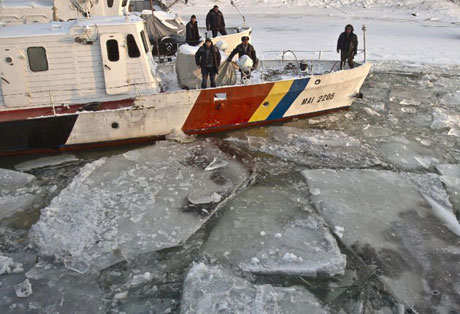The second longest river in Europe freezes, traffic is paralyzed
The water transport industry costs several million euros a day because the Danube, the second longest river in Europe, freezes, making boats unable to travel from Austria to the Black Sea.
Large ice floats floating on the Danube from the early days of February, after cold air flows from the Arctic spilled across Europe, causing temperatures in many areas to below -10 degrees C. Hungary, Austria, Croatia, Romania, Serbia, Bulgaria banned waterway transport on the Danube on February 14 due to the large density of ice.

An icebreaker ship on the Danube river in southern Romania on February 8.
In Romania alone, officials blocked a river section of up to 700km, the AP said. The Hungarian Navy mobilizes the largest icebreaker to the river section passing through Budapest.
"I've never seen so many tapes like this on the Danube since 1985," said Dezso Kovacs, the ship's captain.
Costache Constantin, a manager of Europolis Shipping & Trading in Europe, said he had never seen icebergs on the Danube since he started working in the shipping industry in 1981.
'This phenomenon caused the transportation industry to lose millions of euros. Transportation of raw materials, coal, minerals, cereals, construction materials are all badly affected , 'he said.
Many transport companies complain that authorities do not make every effort to remedy the situation.
'People have to break ice with the tools they have, but it is hard work. With ice blocks of 5 to 7m in length, many people have to work together to break down , ' Constantin said.
With a length of 2,872km, the Danube flows through 9 countries, including Germany, Austria, Slovakia, Hungary, Croatia, Serbia, Bulgaria, Romania and Ukraine.
- Mud poison spills into the second longest river in Europe
- Which river is the longest in Vietnam?
- Listed 10 longest rivers in the world
- The new discovery helps the Amazon River become the world's longest river
- 23 people died, the northern mountainous traffic was paralyzed due to the flood
- The Amazon River is the longest in the world, so where is the shortest river?
- WWF publishes research on world river maps
- Yangtze River pollution 'irreversible'
- Scientific proof: Tail-running vehicles cause traffic jams
- New discovery of the process of forming the Mekong River
- Seasonal snowstorm in Europe makes traffic stagnant
- Restore legs for paralyzed people
 Is the magnetic North Pole shift dangerous to humanity?
Is the magnetic North Pole shift dangerous to humanity? Washington legalizes the recycling of human bodies into fertilizer
Washington legalizes the recycling of human bodies into fertilizer Lightning stone - the mysterious guest
Lightning stone - the mysterious guest Stunned by the mysterious sunset, strange appearance
Stunned by the mysterious sunset, strange appearance Wachau Cultural Landscape
Wachau Cultural Landscape  Heavy rains last in China, killing 15 people
Heavy rains last in China, killing 15 people 